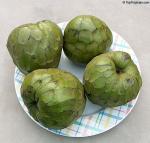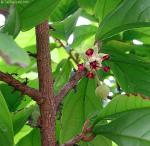 |
Genus of about 50 species of trees and shrubs, native to tropical America, with a few exceptions.
The Cherimoya (Annona cherimola), native to the mountain valleys of Peru and Ecuador, was early introduced into Mexico and Central America. It is a small, somewhat spreading tree, rarely more than 25 feet in height, and normally begins to produce fruit when 4 to 5 years of age. The leaves vary in size; in some varieties they reach a length of 10 inches. The upper surface of the leaves is sparsely hairy and the lower surface is velvety-tomentose.
The cherimoya is often considered one of the best-tasting fruits in the world, its commercial production hampered by its short shelf-life, often tender skin and difficulty harvesting the fruit. Seeds are toxic and when crushed can be used as an insecticide.
Flowers are formed in small groups at nodes along the branches. A single flower first opens as female, which lasts for 36 hours, followed by a male stage, lasting for another 36 hours. Flowers are almost never pollinated by their own pollen, and without proper pollinators which do not exist outside its native range, cherimoya's must be hand pollinated. Pollen is generally collected from a few male flowers and stored in a small bag while it is used to pollinate female flowers. Pollen cannot be stored for more than a few hours before it loses viability.
Flowers bloom from late winter to early summer, followed by fruit which ripen from October to May. Fruits are large, from 4-8" long, and sometimes weighing over 5 pounds. Harvest fruits when skin turns slightly yellow or pale green, or when skin gives a little to touch. |
 |


